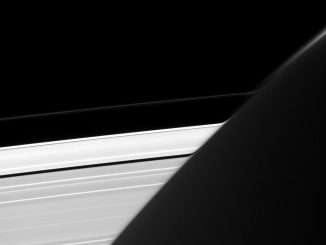
This two-tone, almost yin-yang like image of Iapetus, Saturn’s third largest moon, is the view Cassini was privilege to when it did its second closest approach of the satellite earlier this year. It has been a few years since Cassini first flew by Iapetus and part of the reason for Cassini’s return visit is a closer inspection of subtle colour differences within the moon’s bright terrain.
In this view, obtained at a distance of approximately 621,000 miles (1 million kilometres) from Iapetus, a number of prominent basins and craters can be identified; the Turgis basin can be seen within the dark terrain towards the lower right, while in the middle on the right is Falsaron, a slightly smaller crater. Two prominent craters are also evident in the bright north region and the darkened rim of the crater Naimon can just been seen around the three o’clock position.
This stunning natural-colour view of Iapetus was taken with Cassini’s narrow-angle camera and is a combination of images using red, blue and green spectral filters. In order to make the dark terrain visible, the moon’s brightness has also been enhanced and the image itself has been enlarged by a factor of two compared to the original data. The image scale on Iapetus is about 4 miles (6 kilometres).



